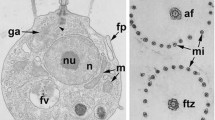Abstract
The structure of the flagellar apparatus of excavate flagellate Histiona aroides has been studied. Two naked flagella emerge from the bottom of ventral groove. The proximal part of the kinetosome has an osmiophilic cone. The posterior short flagellum bears a wide fold, which directs to the cell and contains striated material. The wide dorsal microtubular band starts close by the kinetosome of the anterior flagellum, the left and right bands of the band are divided in turn into two bands, and a single microtubule begins nearby the kinetosome of the posterior flagellum. Amorphous and striated fibrils accompany these bands. The left external band and a multilayer structure (band C) penetrate into the epipodium. The microtubular bands reinforce the bottom of the ventral groove and the external margin of the velum. In addition, the vesicular nucleus, extrusomes, contractile vacuole, and mitochondria with tubular cristae are visible on the cell sections. The similarity of H. aroides with representatives of the Jakobida family and other Excavata is discussed.
Similar content being viewed by others
References
Myl’nikov, A.P., Morphology and life cycle of Histiona aroides Pascher (Chrysophyta), in Biologiya vnutrennikh vod: Inform. Byul. (Inland Water Biology: Information Bulletin), Leningrad, 1984, vol. 62, pp. 16–19.
Myl’nikov, A.P., Morphology of the colorless flagellate Histiona aroides, in Biologiya vnutrennikh vod: Inform. Byul. (Inland Water Biology: Information Bulletin), Leningrad, 1988, vol. 80, pp. 43–46.
Myl’nikov, A.P., Fine structure and taxonomic position of Histiona aroides (Bicoecales), Bot. Zh., 1989, vol. 74, no. 2, pp. 184–189.
Arndt, H., Dietrich, D., Auer, B., et al., Functional diversity of heterotrophic flagellates in aquatic ecosystems, in The Flagellates. Unity, Diversity and Evolution, London: Taylor and Francis, 2000, pp. 240–268.
Flavin, M. and O’Kelly, C.J., Reclinomonas americana n. g., n. sp., a new freshwater heterotrophic flagellate, J. Eukaryot. Microbiol., 1993, vol. 40, pp. 172–179.
Lara, E., Chatzinotas, A., and Simpson, A.G.B., Andalucia (n. gen.)—the deepest branch within jakobids (Jakobida; Excavata), based on morphological and molecular study of a new flagellate from soil, J. Eukaryot. Microbiol., 2006, vol. 53, pp. 112–120.
O’Kelly, C.J., The jakobid flagellates: structural features of Jakoba, Reclinomonas and Histiona and implications for the early diversification of eukaryotes, J. Eukaryot. Microbiol., 1993, vol. 40, pp. 627–636.
O’Kelly, C.J., Ultrastructure of trophozoites, zoospores and cysts of Reclinomonas americana Flavin and Nerad, 1993 (Protista incertae sedis: Histionidae), Eur. J. Protistol., 1997, vol. 33, pp. 337–348.
O’Kelly, C.J. and Nerad, T.A., Malawimonas jakobiformis n. g., n. sp. (Malawimonadidae n. fam.): a Jakoba-like flagellate with discoidal mitochondrial cristae, J. Eukaryot. Microbiol., 1999, vol. 46, pp. 522–531.
Patterson, D.J., Jakoba libera (Ruinen, 1938), a heterotrophic flagellate from deep oceanic sediments, J. Mar. Biol. Assoc. U.K., 1990, vol. 70, pp. 381–393.
Simpson, A.G.B., Cytoskeletal organization, phylogenetic affinities and systematics in the contentious taxon Exacavata (Eukaryota), IJSEM, 2003, vol. 53, pp. 1759–1777.
Simpson, A.G.B., Bernard, C., and Patterson, D.J., The ultrastructure of Trimastix marina Kent, 1880 (Eukaryota), an excavate flagellate, Eur. J. Protistol., 2000, vol. 36, pp. 229–251.
Simpson, A.G.B. and Patterson, D.J., The ultrastructure of Carpediemonas membranifera (Eukaryota) with reference to the “excavate hypothesis”, Eur. J. Protistol., 1999, vol. 35, pp. 353–370.
Simpson, A.G.B. and Patterson, D.J., On core jakobids and excavate taxa: the ultrastructure of Jakoba incarcerate, J. Eukaryot. Microbiol., 2001, vol. 48, pp. 480–492.
Tikhonenkov, D.V., Species diversity of heterotrophic flagellates in Rdeisky reserve wetlands, Protistology, 2007–2008, vol. 5, pp. 213–230.
Author information
Authors and Affiliations
Corresponding author
Additional information
Original Russian Text © A.P. Mylnikov, A.A. Mylnikov, 2014, published in Biologiya Vnutrennikh Vod, 2014, No. 4, pp. 32–38.
Rights and permissions
About this article
Cite this article
Mylnikov, A.P., Mylnikov, A.A. Structure of the flagellar apparatus of the bacterivorous flagellate Histiona aroides Pascher, 1943 (Jakobida, Excavata). Inland Water Biol 7, 331–337 (2014). https://doi.org/10.1134/S1995082914040130
Received:
Published:
Issue Date:
DOI: https://doi.org/10.1134/S1995082914040130



